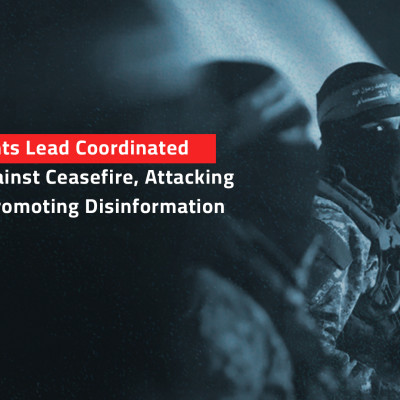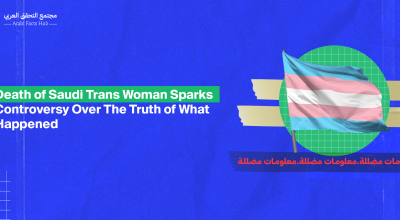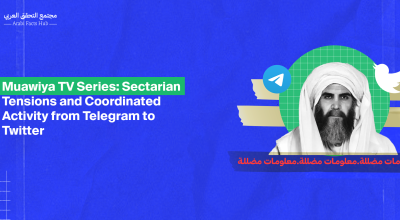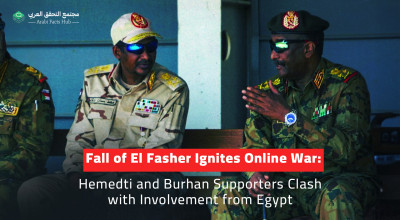“Abbas, leave!” VS “We want to live”: Disagreement Between Fatah and Hamas Shifts to Twitter.. Accounts Associated with Saudi Arabia Chime In
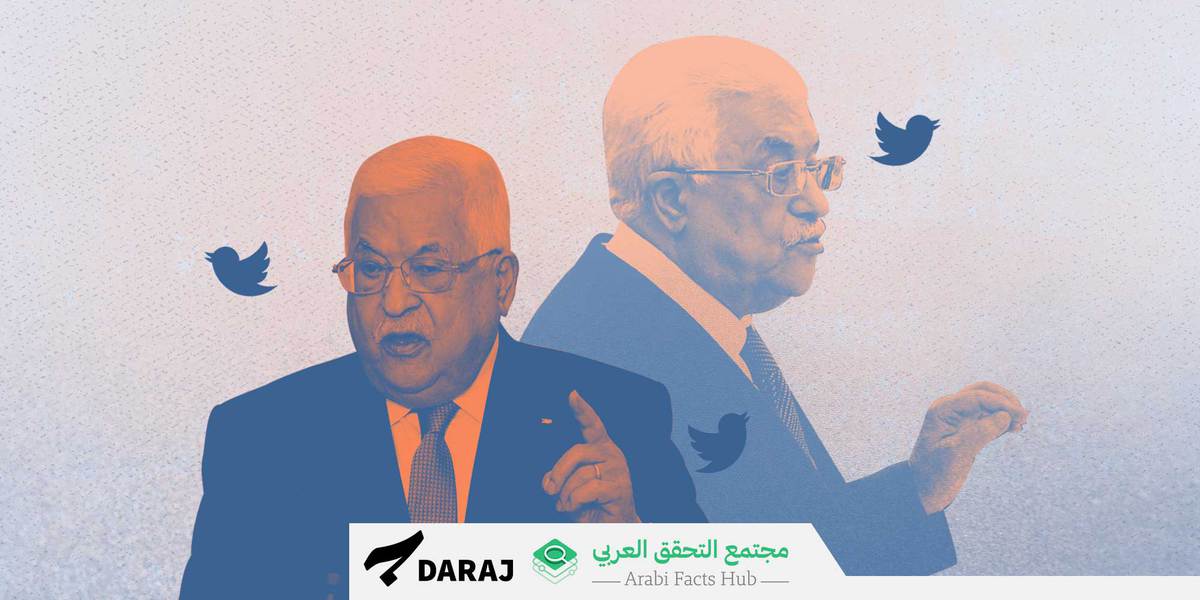
This is part of a series of investigative reports published in collaboration with Daraj media
How can Twitter be leveraged as a battleground in the conflict between Palestinian factions and regional powers seeking influence? This analysis delves into how governments and influential entities exploit the platform's potential to amplify and inflame political divisions, often at the cost of pressing issues.
__________________________________________________________________________________
Arabi Facts Hub (AFH) is a specialized research project that utilizes software to support Arab fact-checking platforms. This includes establishing a unified technical standard database that aggregates content from fact-checking platforms electronically. This enables wide-ranging search and analysis tools. The project aims to integrate artificial intelligence and machine learning techniques into its framework. Additionally, the project provides services, such as the "Eye on Twitter" reports, utilizing technological tools to track and identify sources of misinformation campaigns and hashtags associated with misleading news on social media. "Daraj" publishes this report in partnership with AFH.
__________________________________________________________________________________
How can Twitter be strategically utilized as a battleground amid the conflict between Palestinian factions and regional powers vying for influence? This analysis delves into an issue where governments and influential entities exploit its potential to magnify the conflict, inflaming political divisions at the expense of critical concerns.
Originating in Egypt, the inaugural tweet under the hashtag “We Want to Live” emerged on October 28, 2011, eventually transforming into a conduit for expressing dissent against governments across various Arab nations, including Syria, Kuwait, and, notably, Gaza, the latter, under Hamas control since 2007 after a prolonged conflict with the Palestinian Authority.
By the end of July 2022, the hashtag resurfaced prominently on Twitter, accompanied by a surge in the number of concurrent tweets within specific days.
During that period, tweets under the hashtag featured expressions of vehement protest against the performance of the Hamas government in the besieged Gaza Strip, home to over two million people.
The hashtag preceded calls for protests in Gaza on August 5, 2022, echoing the scenario of the 2019 demonstrations led by a movement also named “We Want to Live”.
While some tweets appeared to be a spontaneous reaction to the frustration over the deteriorating conditions in the strip, our analysis revealed a significant proportion of tweets originating from Saudi accounts, positioning the Kingdom at the forefront in terms of tweet volume.
Simultaneous to activity on the #We Want to Live hashtag, two other hashtags gained momentum: #Abbas, Leave and #The People Demand Elections. Both heavily relied on a vast network of fake accounts (Bots), attempting to compete with traction on the first hashtag. Several indicators suggest that both hashtags are associated with accounts closely linked to Hamas.
What happened?
In 2011, there was one tweet from Egypt on the hashtag, the language of which is closer to the colloquial levantine dialect than it is to Egyptian. This was during the wave of protests calling for the military council to hand over power to civilians.
.jpg)
The hashtag was picked up by Saudi and Kuwaiti accounts the following year, coinciding with protests against the government of Jaber Al Mubarak Al Sabah.


Spanning over a decade, the hashtag has sustained consistently low tweet rates. During its peak periods in 2019 and 2022, it ultimately garnered over 12,354 tweets, more than 27,325 retweets, and at least 72,673 likes as of November 2022. Notably, its recent resurgence in activity was linked to a tragic event – the loss of seven young residents of the strip in late October, as they sought to migrate to Europe.

The infographic illustrates the peak periods of the hashtag #We Want to Live in 2019 and 2022, utilizing the original tweet index (depicted in orange) through the InVID tool.
Key Moments in the Lifespan of the Hashtag
March 2019:
In tandem with the economic protests in Gaza at the beginning of 2019, also known as the 'We Want to Live’ protests, the hashtag #We Want to Live gained momentum, reaching its peak on March 18th. This surge followed shortly after demonstrations which were forcefully dispersed by the Hamas security forces. Throughout March, the hashtag accumulated over 5,500 tweets, nearly 19,300 retweets, and 26,700 likes.
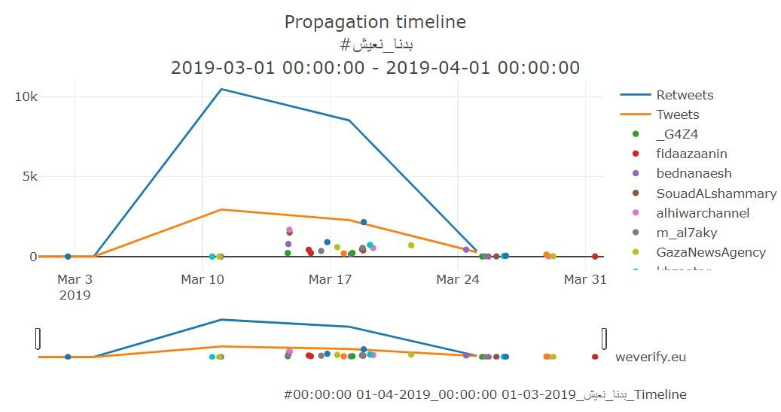
While Hamas suppressed protesters on the ground, a similar uproar unfolded on social media. During that time, Saudi accounts were among the most active and engaged with the content.
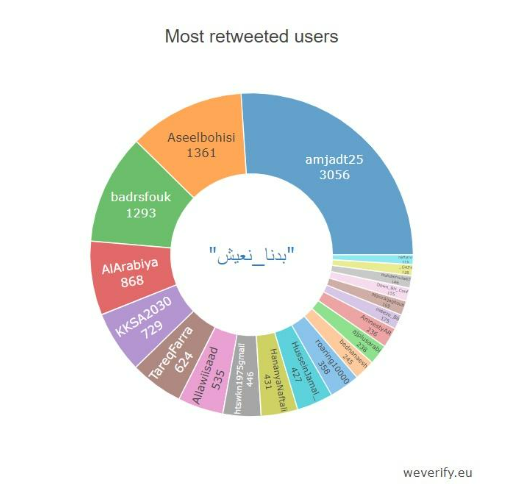
(An illustrative chart from the InVID tool highlights prominent accounts whose content was widely retweeted.)
Among these, Amjad Taha stood out. He is recognized as a Saudi political analyst and an advocate for normalization with Israel. Amjad's tweets within the hashtag garnered over 3,000 retweets and 2,000 likes.
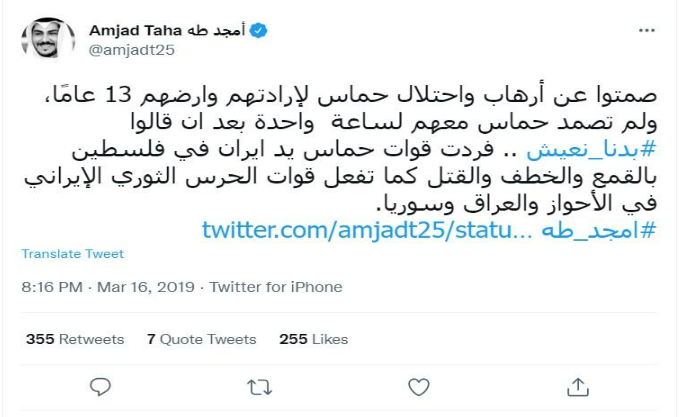
Hours before the recent escalation in Gaza between Israel and the Islamic Jihad Movement (August 5, 2022), Amjad posted another tweet, anticipating the planned demonstrations on the same day. He wrote, “Get ready, after Friday, a new phase will begin in the occupied Gaza by the terrorist entity Hamas. A phase to overthrow Hamas for the protection of the children and women of Gaza. The unified slogan is #We Want to Live. Your voice will reach everyone, and the West Bank is with you.'”

In addition, the channel 'Al Arabiya,' added the hashtag to six tweets to promote it, incorporating it into its coverage of the clashes in the streets of Gaza and raising questions about the possibility of the sector entering a civil disobedience phase. Al Arabiya's tweets garnered over 800 retweets and 900 likes.

There were also Saudi accounts, self-identified as social influencers, such as the account @KKSA2030.
Upon reviewing the account's content, it typically shares tweets applauding the Saudi Crown Prince and criticizing Turkey and the Muslim Brotherhood. Additionally, it reports to official authorities on images of tweets or audio episodes on the Clubhouse app.

Also topping the list is the spokesperson for the Israeli government for Arab media, Ofir Gendelman, who posted 18 tweets in both Arabic and English, incorporating the hashtag. These tweets gathered over 1,600 retweets and 1,900 likes.

July 2022
Intensive activity surged once again through the hashtag since the beginning of July, reaching its peak on the 25th, driven by over 2,000 tweets and 3,000 retweets, garnering 21,000 likes.
Tweet frequency via the hashtag decreased in early August, but it maintained a steady rate which was concurrent with mobilization for protests scheduled in Gaza on Friday, August 5.
Typically, these spikes in tweeting during specific times or on particular days may indicate coordinated, non-organic activity, despite the tangible anger in Gaza towards the Hamas government.

From Hamza Al-Masri to "Muneer, the son of Palestine, created this hashtag.”
Alongside Turkey, Saudi Arabia was among the countries from which tweets emerged using the hashtag #We want to live during the month of July, as indicated by the map from the Hashtagify tool below

To understand the insights provided by the initial analysis map from Hashtagify, we utilized the SNA-InVID tool. The diagram below illustrates prominent contributors to the hashtag, who often retweet what they share.
First, most prominent accounts on Twitter, Facebook and Telegram have tens of thousands of followers. This explains the rapid spread and reach of the hashtag to a large audience.
Then there is "activist Hamza Al Masri," who claims to reside in Istanbul, Turkey. Al Masri has actively used his pages and accounts to rally support through the #We Want to Live hashtag, alongside criticizing Hamas.
Searching for Hamza indicates that Hamas authorities had previously arrested him in recent years due to his anti-Hamas comments on social media. Hamza had a Facebook page with around 270,000 followers. Initially created in December 2013 under the name "Support for Our People in Burma," it was later renamed to "Support Your Brother Hamza and Muslims in Burma" in November 2021. A week later, it was renamed to bear only his name. In November 2022, the page disappeared without a known reason.
During our investigation, we initially identified administrators for Hamza's page in different countries: 5 in Turkey, 2 in Germany, 1 in Israel, and another in Palestine. In early September 2022, the administrators in Germany disappeared, and Facebook's transparency feature recorded the addition of another administrator from an unknown location.
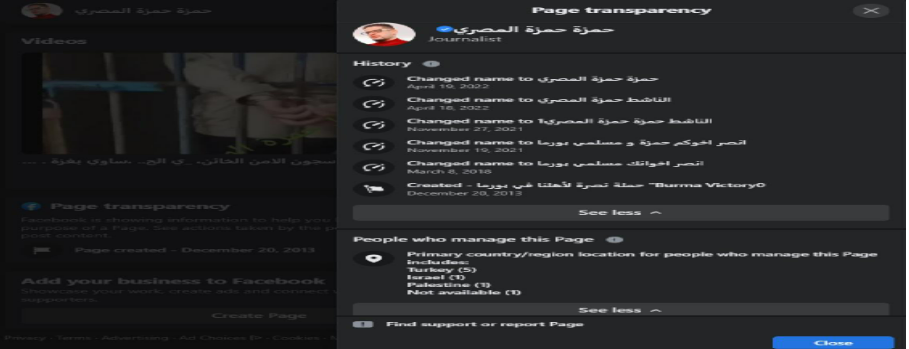
Hamza is also notably active on the instant messaging app Telegram, using his channel "Activist Hamza Al Masri" to spread news, comments, and posts attacking Hamas. He is followed by over 67,000 people, according to the TgStat tool.

Hamza was one of the prominent contributors to the #We Want to Live hashtag on Twitter, and his recent account is identified as the "alternative account" after Twitter banned his previous 7 accounts.

According to the Hashtagify tool, past statistics associated with Hamza's active accounts and their follower count could explain why Turkey appears prominently among the countries generating tweets during the #We Want to Live campaign. Examining the content of these accounts reveals that some strongly sympathize with Saudi Arabia, while others lean towards defending and participating in previous virtual campaigns aligned with Saudi discourse and with organized Saudi campaigns.
Some accounts use the Saudi flag in their profile picture or associate it with the flag of another Arab country, likely the country where the account holder resides.

For instance, this account, @muneer798, identifies itself as "Muneer, the son of Palestine." Muneer has 11,000 followers on Twitter and over 38,000 subscribers on his YouTube channel, which has garnered 5 million views since its launch on September 17, 2020.
In one of his tweets, Muneer states that he is Palestinian, specifying on his Twitter account that he lives in Ramallah in the West Bank. However, in the "About" section of his YouTube channel, he claims to reside in Jordan.
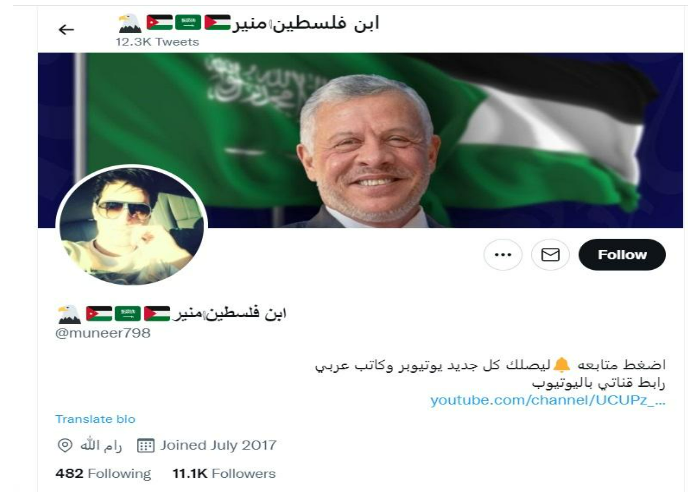
The contents of Muneer's accounts indicate a strong inclination towards Saudi Arabia, as evident in his writings, influential contributions to various hashtags and campaigns, such as "Boycott Turkish Products," #Houthi_Massacre_in_Shabwah (Yemen), #Popular_Boycott_Movemet_ in_Lebanon, #Palestinians_with_Saudi_Arabia, #Lebanon_is_not_doing_well.
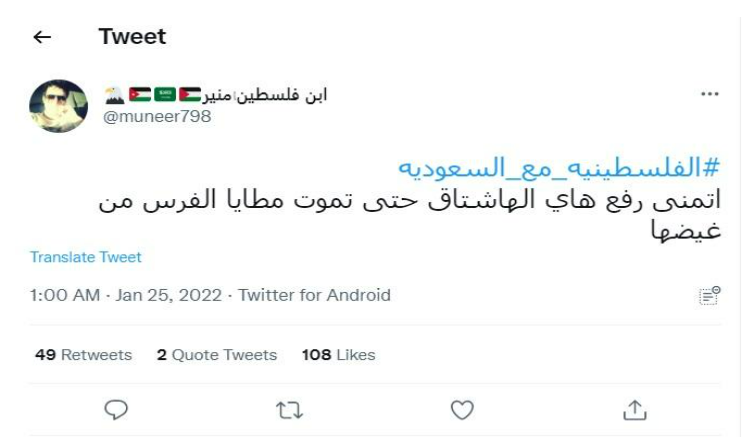
It seems that Muneer's intensive involvement in campaigns and online activism has led to the loss of many "backup" accounts before his current one, according to his statements. The screenshot below illustrates how Muneer had other accounts, including one named "Sword of the Arabs," which he used for online trolling. He prominently featured the Saudi flag in the profile picture of this account.

"Long live Egypt” from the “Kurdish” daughter of Palestine
The MeVer Graph Analysis tool estimates that a significant number of accounts using the #We Want to Live hashtag are interconnected and follow each other. On a winter evening in January 2021, an account named "Palestinian Daughter – @BMBMB2020" responded to a tweet from the account "Muneer, the son of Palestine." We observed that the two accounts were already following each other.

The account "Palestinian Daughter," created in September 2020, is one of the most retweeted accounts in the #We Want to Live hashtag. It has 98 tweets that were retweeted 219 times with over 600 likes.
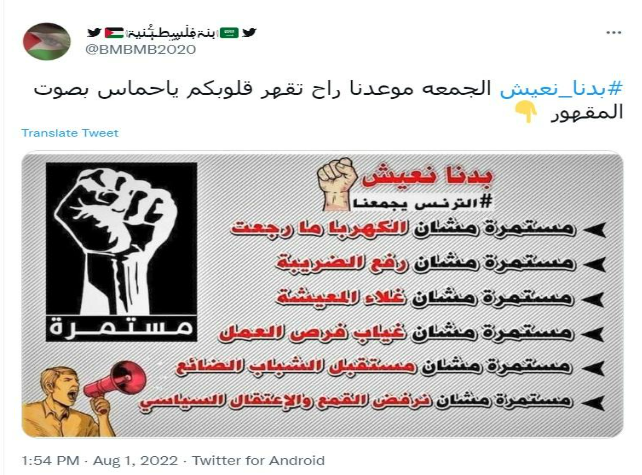
But it seems the account is part of a larger network operating across the Arab world. For each country and regional issue, there are accounts managed by individuals or the same entity, with names varying from one place to another. Upon examining the account's archive, we found that it tweeted on December 28, 2020, seeking support from other accounts because Twitter had temporarily restricted it. Some of these accounts were entirely closed by Twitter.
In the tweet, the account indicated that Twitter had suspended its main account (@NazJaf4), with the number 4 possibly implying the creation of at least four accounts with the same name before Twitter took action against them. The account manager presents herself as an independent veiled journalist with a bachelor's degree in electrical engineering, residing in Berlin, Germany. The account was created in May 2020 and has 14,000 followers.

There was a pinned tweet where Naz Najar expressed pride in her Kurdish identity. In the account's bio, we noticed the presence of another handle, "My second account - @naz_najar," which has a similar name and features an image combining Saudi Crown Prince Mohammed Bin Salman and the President of the Kurdistan Region, Nechirvan Barzani. This account was created in October 2020, and its content focuses on Iran, Saudi Arabia, Hezbollah, and the Shia militia.

The heat map from the InVID tool shows that tweeting activity on the #We Want to Live hashtag was continuous over the 24 hours. However, it was more intense around midnight GMT, at 11 AM and 12 PM, 2 PM, and 8-9 PM, all known as peak hours preferred by marketers for promoting their products in general.

#Abbas, leave!
On the evening of July 27, 2022, the hashtag #Abbas Leave unexpectedly gained momentum with a significant surge in tweeting activity on Twitter. On that night alone, 2,645 tweets were posted.
From July 27 to the morning of August 4, a total of 2,980 tweets were published on the hashtag, along with 9,441 retweets and 2,728 likes. As the activity continued, by November, a total of 3,555 tweets, 9,645 retweets, and 3,305 likes had been posted under the hashtag.
Activity on the hashtag emerged slightly later than on the #We Want to Live hashtag, but it almost equaled it in reaching its peak by the sudden posting of a large number of coordinated tweets within a short timeframe.

At first glance, the sudden surge in the #Abbas Leave hashtag could be interpreted as a response to the first hashtag. There were indications that this coordinated campaign was carried out through accounts closely associated with Hamas.
Among these indicators is the use of the classic method commonly used in virtual campaigns, which involves using scripts with specific uniform phrases often embedded in tweets frequently published by a legion of fake accounts.
In a similar vein, a complementary campaign to the hashtag calling for the departure of the President of the Palestinian Authority emerged. The new hashtag, #The People Demand Elections, saw a sudden spike on August 3, 2022. The tweeting activity continued, but at a lower pace, with stability and diversification in phrases and accounts used in the campaign between August and November.
During this period, there were over 4,367 tweets, 6,976 retweets, and 2,050 likes.
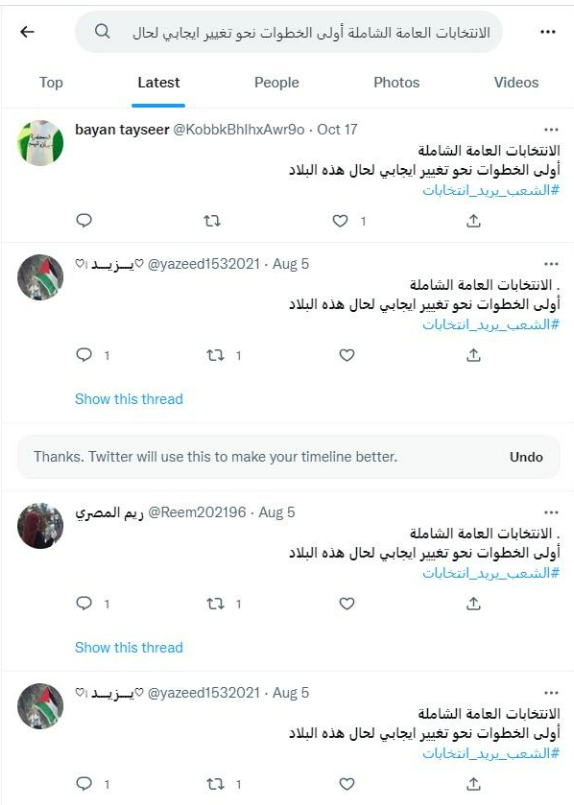
But why elections?
In April 2021, the President of the Palestinian Authority announced his refusal to hold elections without the participation of Jerusalem. At that time, observers stated that Abbas's rejection was linked to polls anticipating a significant victory for Hamas over Fatah in the elections. Hamas objected to the decision to postpone the elections.


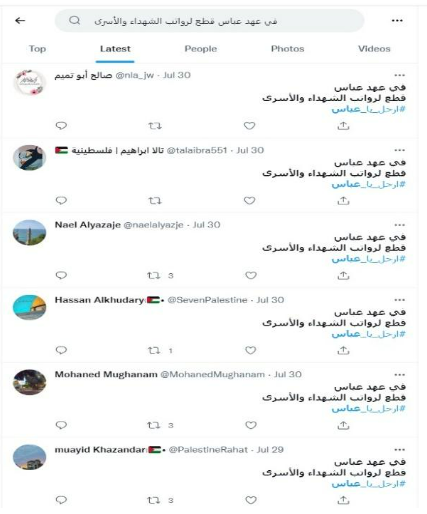
*Examples of Duplicated Content
Another interesting fact was the consistency in the hours during which both hashtags were active, between 10 AM and 4 PM GMT, according to SNA-InVID data. Both hashtags relied on new fake accounts and others that were part of previous virtual campaigns supporting Hamas on Twitter.
For instance, the account @Imad01011 was created in July 2021 and was first used in a tweet praising the operation carried out by Hamas called "Operation Protective Edge" in July 2014, during the conflict between Israel and Palestinian armed factions.
This account was again used for the ongoing virtual campaigns attacking the president of the Palestinian Authority and demanding elections. It alone published 164 tweets under the #Abbas Leave hashtag.
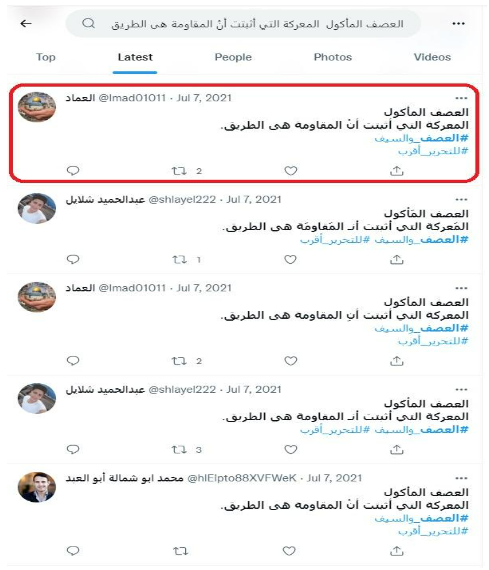

In summary:
- Twitter served as a battleground between Palestinian factions and regional powers seeking influence.
- Promoters of the #We Want to Live hashtag adopted better developed methods to adapt to Twitter's efforts to limit the spread of coordinated activity, where accounts that appeared to be organic responded to other accounts.
- Some tweets appeared genuine and not fake or directed, while accounts that displayed the Saudi flag and adopted the Kingdom's rhetoric concealed their identity behind personalities claiming to be Palestinian.
- Accounts changed their tone depending on the relevant issue or country in question.
- While promoters of the hashtags #Abbas Leave and #The People Demand Elections relied on the classic method of primarily using armies of fake accounts to broadcast repeated unified messages, making it easier for observers to discover who might be behind this coordinated content and hinder its activity.
- Regarding the two hashtags, we found both newly created accounts and others that were active in previous campaigns.
- Twitter managed to remove some accounts, but the organizers of virtual campaigns could still bypass policies applied by social media platforms.
- Although a portion of the tweets seemed organic and in line with the frustration over the deteriorating conditions in the strip, our analysis of the hashtags showed that a significant percentage of the tweets were disseminated by Saudi accounts, making the Kingdom the top tweeter.
Tools Used:
InVID Verification Plugin
Twitter Search
Apify
Hashtagify
MeVer Graph Analysis
Tgstat


